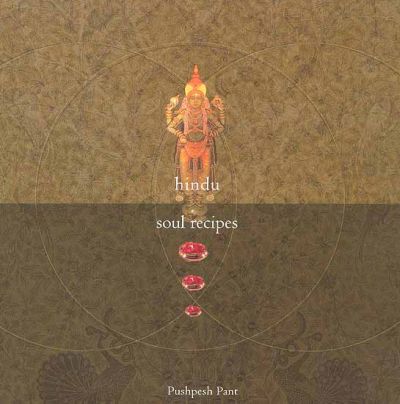Hindu Soul Recipes
Pushpesh Pant
Pant, Pushpesh;
Hindu Soul Recipes
Roli Books, 2007, 94 pages
ISBN 8174four 364129, 9788174364128
topics: | food | recipe | india
In Ayurvedic thought, there are six types of body constitution or doshas: kapha, pitta, and vAta, plus the three combinations; and five temperaments: satvik, tamasik, rajasik, and _satvik-rajasik, rajasik-tamasik (satvik and tamasik_ cannot go together). "Soul food" consists of determining what food would suit which body / personality, and how these tie in with external variables like the seasons. However, this rather interesting topic is really not addressed; the discussion is airy and insubstantial. Despairingly, one searches for answers, but none are to be found, e.g. the doshas relate to the three elements - water, air, and fire - but the "relation" is never elaborated. pitta tends to be elevated in the summer and in the rains, but vAta may also be high - the only food prescription suggested is that "ingredients that counteract pitta-vAta in summer and kapha-vAta during rains are prescribed in Ayurveda". What these ingredients are is not alluded to. It is clear that the author has hazy notions that are as airy as the sanskrit terms liberally strewn everywhere. After this despairingly inadequate intro, the book moves rather abruptly into the recipes, which bear Sanskritic or alien names in the text (Rajamasha is Rajma, Suparna is cabbage leaf). The recipes are accompanied by small cultural histories - Shaak, leafy greens - comes from Shakambhaare, the goddess of plants. The sanskrit name for bitter-gourd, Karvellaka, means "that which adorns a vine". Each menu is introduced briefly, these are a little better, but again, they are lightweight and lack depth; one wonders about their accuracy even. The photographs by Dheeraj Paul are good - better than the average photo cookbook perhaps. However, if you need more substantiated historical information on Indian food, with detailed links to Indus valley artifacts, and texts ranging from Charaka Samhita to Fa Hsien, Al Beruni, and Ain-i-Akbari, read Achaya, even his small easily available The story of our food.
amitabha mukerjee (mukerjee [at-symbol] gmail.com) 2011 Jul 04